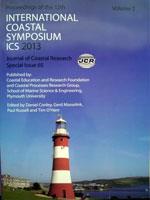Costa, K.G., Bessa, R.S.C., Pereira, L.C.C., Costa, R.M., 2013. Short and medium-term changes of Pseudodiaptomidae copepods in the Amazonian Mangrove Coast: the Paracauari River estuary. In: Conley, D.C., Masselink, G., Russell, P.E. and O'Hare, T.J. (eds.)
Given the importance of copepods in pelagic food webs, short- and medium-scale temporal variation in the distribution and abundance of copepods of the genus Pseudodiaptomus was investigated in an oligo-mesohaline estuary (Paracauari) in northern Brazil. This system is characterized by high local hydrodynamics and nutrient input from the Paracauari River and Marajó Bay, and marked seasonal variation in rainfall levels. The temporal variation in the abundance of copepods was analyzed in the context of some hydrological variables — tide height, salinity, temperature, pH, and concentrations of suspended particulate material, dissolved oxygen and chlorophyll a. Samples were collected in 2009 at a fixed station (00°44′15.4″S, 48°31′07.5″W) every 3 hours during a nycthemeral cycle in the neap and spring tides of February, May, June, August, November, and December. Zooplankton samples were collected using horizontal hauls of plankton nets with a 120 μm mesh. Following identification, the abundance and density of Pseudodiaptomus copepods were determined. Data were analyzed using an ANOVA (to assess the significance of diurnal, fortnightly and seasonal variations), PCA, and Bray-Curtis similarity. Four species were identified: Pseudodiaptomus richardi, Pseudodiaptomus marshi, Pseudodiaptomus gracilis, and Pseudodiaptomus acutus. The results indicate that variation in composition and density of the Pseudodiaptomidae copepods in the Paracauari estuary is determined by the interactive effect of the freshwater influx from Marajó Bay, tides, and the rainfall regimen, which modulate local salinity. The absence of diurnal variation in species composition and density was determined by the high local hydrodynamics, which provoke the constant mixing of the estuary's water.





